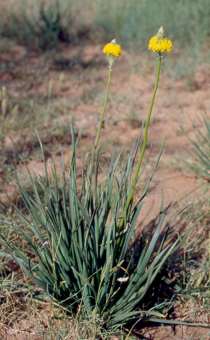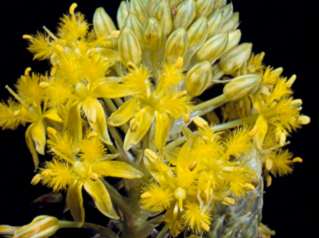Bulbine narcissifolia
Bulbine narcissifolia Salm-Dyck
Family: Asphodelaceae
Common names: strap-leaved bulbine, snake flower (Eng.); lintblaar bulbine, geelslangkop, wildekopieva (Afr.); khomo-ea-balisa, serelelile (Southern Sotho)
Introduction
The grey-green, laxly twisted leaves and compact inflorescence of yellow flowers and white bracts covering the flower buds, make the strap-leaved bulbine, Bulbine narcissifolia, a very attractive plant. This plant is hardy and water-wise and will offer a brilliant yellow flower display without requiring a lot of attention.

Description
Description
Bulbine narcissifolia is a succulent, stemless, perennial herb with a rhizomatous base. Plants grow singly or in small clumps. The grey-green leaves are strap-shaped, laxly twisted, semi-succulent and up to 350mm long with a yellowish exudate. Several dense, many-flowered, spike-like inflorescences are formed from a plant during spring and summer. Flowering occurs mainly during February to April and September to November.

The compact inflorescences are erect and up to 500mm tall with prominent white, membranous bracts covering the flower buds. The bright yellow flowers are star-shaped with bearded stamens and mature from the bottom of the inflorescence. The stalks of the old flowers and fruit are straight, erect and almost completely adpressed against the central axis of the inflorescence.
Conservation Status
Status
Bulbine narcissifolia is not threatened and can be very common in certain areas throughout its wide distribution range. It often forms stands, especially in overgrazed areas and is very conspicuous during the flowering season.
Distribution and habitat
Distribution description
Bulbine narcissifolia occurs from the far eastern regions of the Western Cape, through the Eastern Cape, KwaZulu-Natal, Lesotho, Free State, North-West, Gauteng, Limpopo, Botswana and further north to Ethiopia. It favours grassland and frequently forms small to large colonies, especially in overgrazed areas.
Owing to its wide distribution, this species is suitable for cultivation throughout the summer rainfall region. It is both frost and drought tolerant and can cope with a wide range of temperatures. In dry, hot years, plants tend to be smaller and have fewer inflorescences than in years of good rainfall.
Certain populations from the Eastern Cape tend to be deciduous, with the leaves dying back during winter and new growth re-emerging in early spring.
Derivation of name and historical aspects
History
The specific epithet, narcissifolia, means with leaves like a Narcissus (daffodil). This refers to the grey-green, strap-shaped leaves of this species that are reminiscent of those of many daffodil species.
The genus Bulbine comprises ± 73 species occurring in Africa and Australia. Whereas only six species are found in Australia, a total of 67 occur in southern Africa, with only five of these also extending into tropical Africa. The genus is therefore essentially a southern African entity. The genus is characterized by succulent plants with lax or compound racemes (flowers borne on stalks along an unbranched axis, lower ones opening first) of mostly yellow (rarely white, orange or pink) flowers with bearded stamens.
The most common Bulbine found in the horticultural trade is both the yellow and orange colour forms of B. frutescens. Several other species are also worthy of cultivation, for instance B. abyssinica, B. latifolia, B. natalensis and of course, B. narcissifolia.
Ecology
Ecology
Like most other species in this genus, Bulbine narcissifolia is insect pollinated and frequently visited by bees.
Uses
Use
Bulbine narcissifolia is used medicinally by the Basotho and Griqua for wound healing and as a mild purgative. As with many other Bulbine species, the roots can also be taken to counteract vomiting, diarrhoea and urinary infections. It is also commonly used to treat diabetes, rheumatism and blood problems.

Growing Bulbine narcissifolia
Grow
Bulbine narcissifolia is ideal to use as an accent plant in a small bed or as a mass display in a large bed. Plants are rather fast growing and drought resistant, making it ideal for water-wise gardening. In its natural habitat it mostly flowers during spring (February to April) and summer (September to November), but can have an extended flowering period in cultivation. The contrasting white bracts and bright yellow flowers on the compact inflorescences form an interesting display. The greyish green, strap-shaped, laxly twisted leaves make the plants very attractive, even when not in flower.
For the best effect, plant this species in full sun together with other hardy, drought tolerant plants. Although B ulbine narcissifolia can tolerate regular watering, it does not require it. A good humus-rich soil will ensure healthy plants that grow fast and flower proliferously. Mulch regularly or cover the bed with pebbles. This will prevent unnecessary water loss from the soil and thus contribute to the principles of water-wise gardening.
Seed propagation is best, but vegetative propagation is also possible. Plants are self-incompatible and therefore no seeds will be formed when only one clone is present. When clumps become very large, they can be carefully divided and replanted, preferably in early spring. Seed can be sown throughout the year, but spring or early summer is the best time to do so. This will give the seedlings ample time to establish before winter. Seeds germinate rapidly, usually within one to two weeks. Seedlings grow fast and can be transplanted when they are at an easily manageable size. Plants often flower within their first year.
Remember that some populations tend to be deciduous. So do not despair and throw out the seedling tray in winter when the leaves die back. Keep the tray dry or only very slightly moist during winter. Start watering in early spring and new leaves will soon appear.
References
- Qhotsokoane-Lusunzi, M.A. & Karuso, P. 2001. Secondary metabolites from Basotho medicinal plants. I. Bulbine narcissifolia. Journal of Natural Products 64: 1368-1372.
- Smith, C.A. 1966. Common names of South African plants. Memoirs of the Botanical Survey of South Africa No. 35.
- Van Wyk, B-E. & Gericke, N. 2000. People's plants: a guide to useful plants of southern Africa. Briza Publications, Pretoria.
Credits
Ronell R. Klopper
Research & Scientific Services Directorate
October 2007
Plant Attributes:
Plant Type: Perennial
SA Distribution: Eastern Cape, Free State, Gauteng
Soil type: Sandy
Flowering season: Spring, Early Summer, Late Summer, Autumn
PH:
Flower colour: Yellow
Aspect: Full Sun
Gardening skill: Easy
Special Features:
Horticultural zones









Rate this article
Article well written and informative
Rate this plant
Is this an interesting plant?
Login to add your Comment
Back to topNot registered yet? Click here to register.